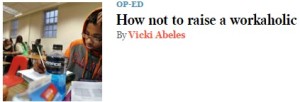No Alcohol for Sexually Active Women Without Birth Control, C.D.C. Recommends
Sexually active women who are not using birth control should refrain from alcohol to avoid the risk of giving birth to babies with fetal alcohol spectrum disorders, even if those women are not yet known to be pregnant, the Centers for Disease Control and Prevention has recommended.
The C.D.C. report, released on Tuesday, estimated that 3.3 million women between the ages of 15 and 44 who drink alcohol risk exposing their infants to the disorders, which can stunt children’s growth and cause lifelong disabilities. The report, which appeared to refer exclusively to heterosexual sex, also said that three in four women who intend to get pregnant do not stop drinking alcohol when they stop using birth control.
“The risk is real. Why take the chance?” Anne Schuchat, principal deputy director of the C.D.C., said in a statement.
Alcohol consumption during pregnancy has been widely linked to stunted physical, mental and behavioral development of children. In October, a report by the American Academy of Pediatrics declared that “no amount of alcohol should be considered safe to drink during any trimester of pregnancy.”
About half of pregnancies are unplanned, and most women do not know they are pregnant until four to six weeks into the pregnancy, the C.D.C. noted. The only way to ensure that the effects of alcohol would not be passed on to a child, then, would be alcoholic abstinence.
The suggestion of indefinite sobriety did not sit well with some women.
Which type of people have unplanned pregnancies? Generally speaking, the less intelligent. Which type of people drink while pregnant? The less intelligent.
From Anonymous Conservative:
Biologists have long noted that species will tend to evolve behaviors which best aid them to effectively exploit their environment. Among these behavioral life history traits are reproductive strategies. Reproductive strategies are, as the name implies, the strategies individuals will use to reproduce. Here we will focus upon the two strategies demonstrated in r/K Selection Theory in Evolutionary Biology.
The science behind r/K Selection theory was hashed out decades ago. It emerged as biologists pondered why some species reproduced slowly using monogamy and high-investment parenting, while other species reproduced explosively, using promiscuity and single parenting. At the time this science was developed, the researchers were wholly unaware of its relevance to our modern ideological battles in the world of politics. The terms r and K came from variables in equations which described how populations would change over time. r represented the maximal reproductive rate of an individual, while K represented the carrying capacity of an environment.r/K selection theory describes two environmental extremes, and the strategies a population will produce to exploit each extreme. As a result of these strategies, each of these two environments will produce a very particular psychology in the individuals exposed to them.
The first environment an organism may face is the presence of freely available resources, which is referred to as an r-selective environment. This most often occurs when a predator keeps a population consistently lower than the carrying capacity of its environment. Just as rabbits do not strip their grassy fields bare due to the predation they endure, the r-strategy is designed to exploit an environment where resources are freely available, everywhere.
In r-selection, those individuals who waste time fighting for food will be out-reproduced by pacifists, who simply focus upon eating, and reproducing. Fighting also entails risks of injury or death – risks which are pointless given the free availability of resources everywhere. Hence this environment will favor a tendency towards conflict avoidance, and tend to cull the aggressive and competitive. It will also evolve tendencies towards mating as early as possible, as often as possible, with as many mates as possible, while investing as little effort as possible rearing offspring. Here, there are unlimited resources just waiting to be utilized, and even the most unfit can acquire them. As a result, it is more advantageous to produce as many offspring as possible, as quickly as possible, regardless of fitness, so as to out-reproduce those who either waste time producing quality offspring or waste time competing with each other.
Since group competition will not arise in the r-selected environment, r-type organisms will not exhibit loyalty to fellow members of their species, or a drive to sacrifice on their behalf. Indeed, the very notion of in-group will be foreign, and the concept of personal sacrifice for other in-group members will be wholly alien. This is why rabbits, mice, antelope, and other r-selected species, although pleasant, will tend to not exhibit any loyalty or emotional attachment to peers. When resources are freely available, group competition is a risk one need not engage in to acquire resources, so this loyalty to in-group and emotional attachment to peers is not favored.
Here in the r-strategy, we see the origins of the Liberal’s tendencies towards conflict avoidance, from oppositions to free-market capitalism, to pacifism, to demands that all citizens disarm so as to avoid any chance of conflict and competition. Even the newer tendencies to support the ”everyone gets a trophy” movement are outgrowths of this competition-averse urge, and desire for free resource availability. Similarly, Liberals are supportive of promiscuity, supportive of efforts to expose children to ever earlier sexual education, and, as the debate over Murphy Brown showed, Liberals are supportive of low-investment, single parenting. Finally, as John Jost has shown, Liberals show diminished loyalty to in-group, similar to how r-selected organisms do not fully understand the reason for even perceiving an in-group in nature.
In the other environment, a population exists at the carrying capacity of its environment. Since there is not enough food to go around, and someone must die from starvation, this will evolve a specific psychology within such a species.

